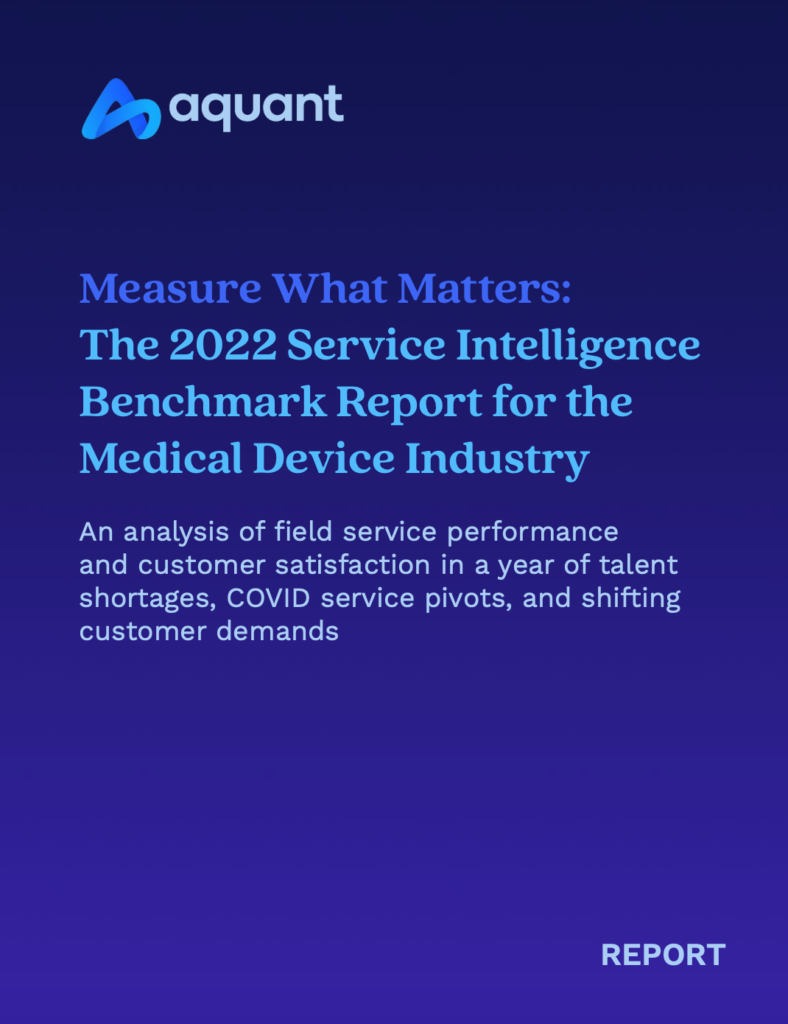How to Look Beyond KPIs
In a recent comprehensive data report, now available at Field Service News, Aquant analyzed how medical device service organizations and their workforce measured up against industry benchmarks and explored service performance from a customer perspective. In this new feature, we discuss how KPIs limit business and how to look beyond them.
How KPIs Limit Business— and How to Look Beyond Them
The Customer Experience Gap
The Customer Experience Gap shows the difference between what customers expect and what your organization delivers.
Our analysis shows that companies who measure FTF rates in 7-day or 14-day windows are setting the stage for a wide experience gap—which leads to frustrating customer experiences.
The moral of the story: a few metrics can’t provide the entire picture. It’s time to look at experience as a whole.

Instead of defining FTF in arbitrary time increments (7 days, 14 days, or 21 days), think about it in terms of the natural service cycle. Our research shows that measuring in 30-day windows strips out false-positive FTF rates.
To understand where your organization falls on the Customer Experience Gap chart, consider the following:
• If your FTF rate is similar when measured at 7 days and 30 days, you have a small gap.
• If your FTF rate has a wide variation (usually a high rate at 7 days and a low rate at 30 days), you have a large gap.
If you have a large gap, your team is focused on hitting their numbers instead of focusing on great customer experiences.
Why FTF Rates Vary by Time
When measured in short windows (like 7-day increments), jobs where a technician made an incorrect fix—but got the machine to work temporarily—will be marked as complete.
But an incorrect fix is only a temporary measure, and the machine will continue to break down until properly repaired. For instance, a customer may call for service two or three times in a 30- day window. If you only measure in 7-day increments, your dashboard may show you successfully completed three jobs for one customer. In reality, these were three failed visits. This environment also leads to customer escalations and customer complaints that management may deem as “surprise complaints” that they didn’t see coming.
When it comes to service, it’s just as important to maximize the time between events and failures as it is to fix things correctly the first time. The less a customer needs a technician on-site, the better. This means the customer’s needs are being met.
The Skills Gap – A Profile of the Top and Lowest Performing Organizations
WHAT DOES THE KNOWLEDGE GAP HAVE TO DO WITH HITTING KPIs?
If there is a large knowledge gap between team members, performance will vary—and so will customers’ experiences. That’s why it’s crucial to make sure that your technicians are equally knowledgeable about the equipment that they service and up-to-date on specific customer preferences.
DETERMINE YOUR TEAM’S SKILLS GAP
To increase your team’s knowledge and success, you must first identify how much of a gap exists between top performers and underperformers.
For this report, we calculated the percentage differences between the 80th percentile of organizations and the 20th percentile.

What’s Next?
The medical device service industry is facing unprecedented workforce shortages and increasing customer demands. A better way to overcome these challenges is to understand your business on a much deeper level than you do today so you can tailor service for every customer.
For more information, visit aquant.io
FSN subscribers can read the full report right now. Please note, this paper will only be available for a limited period for FSN FREE subscribers.

![]() Data usage note: By accessing this content you consent to the contact details submitted when you registered as a subscriber to fieldservicenews.com to be shared with the listed sponsor of this premium content Aquant who may contact you for legitimate business reasons to discuss the content of this white paper.
Data usage note: By accessing this content you consent to the contact details submitted when you registered as a subscriber to fieldservicenews.com to be shared with the listed sponsor of this premium content Aquant who may contact you for legitimate business reasons to discuss the content of this white paper.
Further Reading:
- Read more about Digital Transformation
- Read more about Service Operations
- Read more about Aquant on Field Service News
- Find out more about Aquant
- Follow Aquant on Twitter
- Connect with Aquant on LinkedIn
- Access over 20 premium resources on COVID Recovery and the New Normal (PRO)
- Access over 40 premium resources on digital transformation (PRO)


